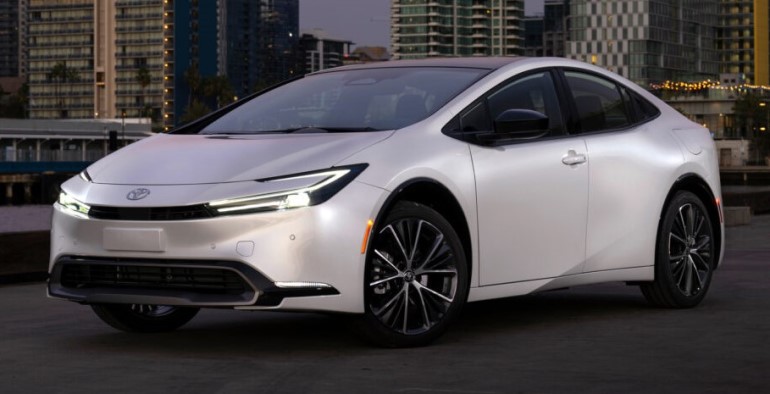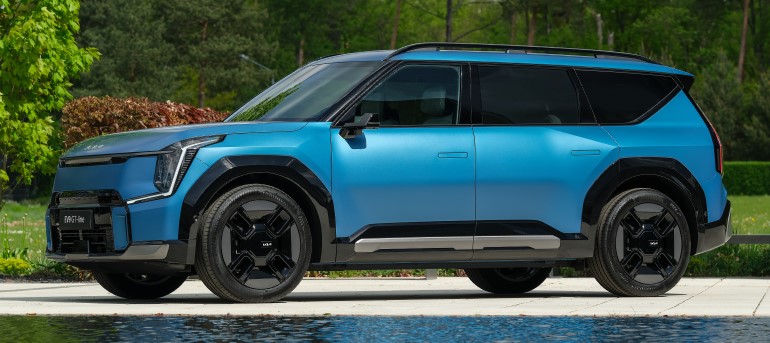PONTIAC, MI – The Toyota Prius hybrid, Ford F-Series Super Duty and Kia EV9 battery-electric vehicle win the 2024 North American Car, Truck and Utility of the Year awards. Our WardsAuto juror on the panel, Drew Winter, gives his take on each of the finalists, along with his pre-announcement picks here (TLDR: Winter gets one out of three correct):
There are a lot of awards for vehicles of the year, but the North American Car, Truck and Utility of the Year (NACTOY) awards are different from most because there are 50 judges from 50 different media outlets throughout the U.S. and Canada.
This type of diversity is significant because media outlets focus on various aspects of vehicles to serve the needs and interests of their audiences. Some focus on hardcore automotive enthusiasts, others have audiences that view vehicles from a more utilitarian viewpoint.
Canadian automotive journalists bring yet another important perspective. We live on the same continent, but Canadians see the world through a different lens. Believe me, I know: I’m married to one.
Still other NACTOY judges come from a technology or industry standpoint, like me.
In addition to being a NACTOY juror, I’m a judge for the Wards 10 Best Engines & Propulsion Systems and Wards 10 Best Interiors & UX. I’ve also spent the past few years writing about what future vehicle cockpits will look like.
In the Wards judging, I don’t knock off a lot of points for high-priced vehicles with spectacular cockpit designs or innovative propulsion systems. The Wards trophies are industry awards, and they recognize industry achievements in design and innovation. My philosophy for the Wards 10 Best is, new industry benchmarks deserve recognition because they eventually trickle down to more affordable models. Vehicle pricing is not critical in this context. And that’s why a lot of premium luxury vehicles with huge price tags make the Wards 10 Best lists. It takes time for advanced technology to be democratized.
The NACTOY judging criteria – as I interpret them – are more general: segment leadership, innovation, design, safety, handling, driver satisfaction and value for the dollar.
NACTOY awards are consumer-facing vs. industry, so my judging criteria usually skew more to affordability, although sometimes technology breakthroughs must be recognized, as is the case with some of the electric vehicles NACTOY has recognized in the past.
Which Vehicles Will Win in the Three Categories?
Without going into a lot of detail, here’s my breakdown of the finalists in each segment:
Car of the Year
Honda Accord/Accord Hybrid
Honda Accord/Accord Hybrid has a base price of $29,000; $34,000 is the starting price for a hybrid version that drives more like a zippy EV that is fun to drive and gets up to 51 mpg (5.5 L/100 km). It has a sleek design, roomy and attractive interior, good cargo space and extremely comfortable seats.
On the downside, all-wheel drive is not available, and it’s not an SUV, which so many consumers want.
Toyota Prius/Prius Prime
The new Prius exterior design is a real head-turner, especially for a car priced under $30,000 for the non-PHEV version and it is rated at an amazing 56 mpg (5.0 L/100 km) on the highway. The interior features an advanced instrument panel and cluster design that is designed to limit driver distraction. As somebody who has been following IP design for a few years, I can tell you it is the wave of the future.
The Prius Prime PHEV version is fast and fun to drive when the battery is charged, but on the downside, the interior design does not match the sophisticated exterior and is very much what we used to call a “Spartan” interior. The forward-mounted gauge has good intent, but the execution could have been better. Also on the downside, the non-PHEV is not nearly as much fun to drive as the PHEV.
Hyundai Ioniq 6 EV
The Ioniq 6 is a great-looking, affordably priced EV sedan starting at about $39,000 and is available with more than 361-mile (580-km) range and the least-expensive model can go 240 miles (386 km). The interior design is well-executed, comfortable and roomy, and the version I tested was lots of fun to drive, but the entry-level model is rear-wheel drive only. I would highly recommend this car to anyone looking for an affordable EV, but I would warn them to plan on spending about $10,000 more to get the performance and features they would want.
My prediction: The Honda Accord will win because it’s the best overall package, but you can’t go wrong with any of these three. The Toyota Prius (pictured, below) wins.
Truck of the Year
Chevrolet Colorado
The Colorado is a midsize pickup available in many different versions and has impressive off-roading chops and an equally impressive starting price of $31,000, with even a ZR2 version available for $48,000.
It’s easy to argue it is the best in its segment, but beating the fullsize beasts will not be easy.
Chevrolet Silverado EV
The Silverado EV is a stunning new competitor in the electric pickup segment touting up to 754 hp, sports-car-like acceleration, towing capacity of 10,000 lbs. (4,536 kg) and lots of advanced connectivity and infotainment features, including 450 miles (724 km) of range for the top model. Chevrolet claims it can add up to 100 miles (161 km) of range to the battery in just 10 minutes at a DC charging station. The interior isn’t flashy, but it is very comfortable.
Exterior and interior design are well done. It’s an impressive truck, but we’re seeing even in the pickup segment that pricing is becoming an issue. The Silverado starts at about $75,000 and runs to about $107,000.
Ford Super Duty
The Super Duty is coming onto the market with the usual extensive list of engines, an incredible 40,000 lbs. (18,144 kg) of towing capacity and an 8,000-lb. (3,629-kg) payload rating. It starts around $47,000 and runs to $100,000 with the midlevel trim at about $65,000, a bargain given the truck’s prodigious capabilities. The interior is well done and has lots of nice meaty knobs and buttons, plus a horizontal touchscreen.
The Ford Super Duty is improved but it is so dominant in its segment it’s hard to tell how much it will move the bar. The Silverado is the opposite. It’s so new – and pricey – it’s difficult to predict how much of an impact it will have on the truck market, given the uncertainty of the EV marketplace.
Meanwhile, the Colorado is affordable and available in so many versions and use cases that it has the most potential to stand out.
My prediction: The Chevrolet Colorado. The Ford F-Series Super Duty (pictured, below) wins.
Utility Vehicle of the Year
SUVs and crossovers are a crucial segment all over the world now and finalists in this all-important category are all EVs.
Once again, you can’t go wrong with any of these three.
Genesis GV70
I spent quite a bit of time in the GV70 last year testing for several awards unrelated to NACTOY and it is one of my favorite vehicles because of its gorgeous exterior and interior design featuring beautiful materials, colors and excellent user experience and infotainment design.
A starting price of $66,500 is extremely competitive in the luxury SUV segment, but the battery range of 236 miles (378 km) is less than I’d expect. Clearly its 429 hp uses up a lot of juice.
Kia EV9
Meanwhile, Kia has been killing it with its internal-combustion 3-row Telluride CUV and it probably will do the same with its EV9, a 3-row utility vehicle that checks all the boxes with a very spacious cabin and delivers an electrified experience that is as successful as the game-changing Telluride. The proportions are quite different from the Telluride, but they work. It has a strong design, drives great with 379 hp and 516 lb.-ft. (702 Nm) of torque and is a rocket ship that goes 0-60 mph (97 km/h) in just 4.5 seconds.
Hyundai Kona
The Kona/Kona EV is the high-value member in this group with the EV version starting at $34,000. The new exterior styling is cool, and the interior is a little roomier, but it’s not real peppy. The range is 260 miles (418 km), which helps hold down cost – and is better than the much more expensive electrified GV70.
My prediction: The Kia EV9 (pictured, below) will win based on overall design and performance even though the GV70 still is awfully pretty. Winter's pick is correct.





